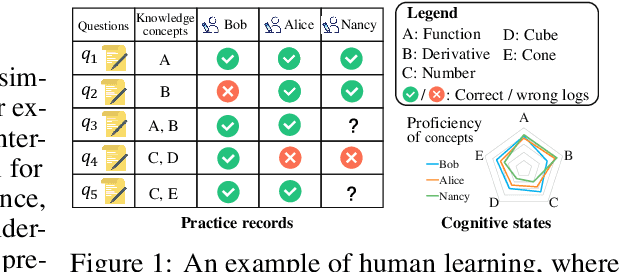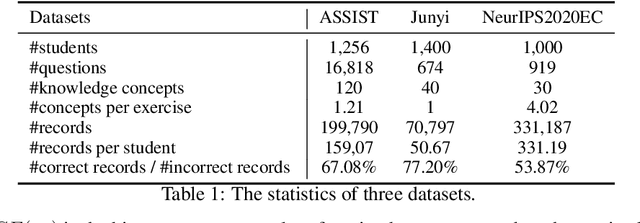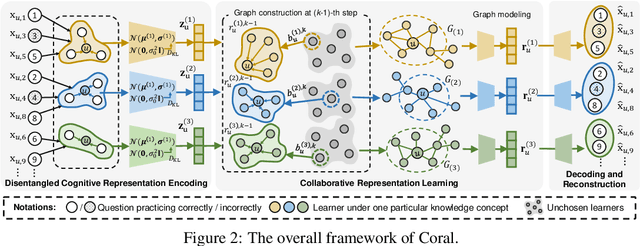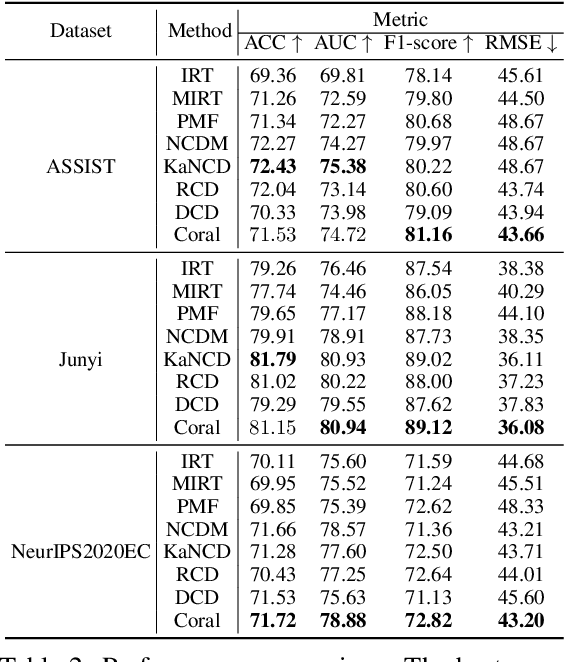Weibo Gao
CoderAgent: Simulating Student Behavior for Personalized Programming Learning with Large Language Models
May 27, 2025Abstract:Personalized programming tutoring, such as exercise recommendation, can enhance learners' efficiency, motivation, and outcomes, which is increasingly important in modern digital education. However, the lack of sufficient and high-quality programming data, combined with the mismatch between offline evaluation and real-world learning, hinders the practical deployment of such systems. To address this challenge, many approaches attempt to simulate learner practice data, yet they often overlook the fine-grained, iterative nature of programming learning, resulting in a lack of interpretability and granularity. To fill this gap, we propose a LLM-based agent, CoderAgent, to simulate students' programming processes in a fine-grained manner without relying on real data. Specifically, we equip each human learner with an intelligent agent, the core of which lies in capturing the cognitive states of the human programming practice process. Inspired by ACT-R, a cognitive architecture framework, we design the structure of CoderAgent to align with human cognitive architecture by focusing on the mastery of programming knowledge and the application of coding ability. Recognizing the inherent patterns in multi-layered cognitive reasoning, we introduce the Programming Tree of Thought (PTOT), which breaks down the process into four steps: why, how, where, and what. This approach enables a detailed analysis of iterative problem-solving strategies. Finally, experimental evaluations on real-world datasets demonstrate that CoderAgent provides interpretable insights into learning trajectories and achieves accurate simulations, paving the way for personalized programming education.
GraphPrompter: Multi-stage Adaptive Prompt Optimization for Graph In-Context Learning
May 04, 2025Abstract:Graph In-Context Learning, with the ability to adapt pre-trained graph models to novel and diverse downstream graphs without updating any parameters, has gained much attention in the community. The key to graph in-context learning is to perform downstream graphs conditioned on chosen prompt examples. Existing methods randomly select subgraphs or edges as prompts, leading to noisy graph prompts and inferior model performance. Additionally, due to the gap between pre-training and testing graphs, when the number of classes in the testing graphs is much greater than that in the training, the in-context learning ability will also significantly deteriorate. To tackle the aforementioned challenges, we develop a multi-stage adaptive prompt optimization method GraphPrompter, which optimizes the entire process of generating, selecting, and using graph prompts for better in-context learning capabilities. Firstly, Prompt Generator introduces a reconstruction layer to highlight the most informative edges and reduce irrelevant noise for graph prompt construction. Furthermore, in the selection stage, Prompt Selector employs the $k$-nearest neighbors algorithm and pre-trained selection layers to dynamically choose appropriate samples and minimize the influence of irrelevant prompts. Finally, we leverage a Prompt Augmenter with a cache replacement strategy to enhance the generalization capability of the pre-trained model on new datasets. Extensive experiments show that GraphPrompter effectively enhances the in-context learning ability of graph models. On average across all the settings, our approach surpasses the state-of-the-art baselines by over 8%. Our code is released at https://github.com/karin0018/GraphPrompter.
The Other Side of the Coin: Exploring Fairness in Retrieval-Augmented Generation
Apr 19, 2025Abstract:Retrieval-Augmented Generation (RAG) enhances Large Language Models (LLMs) by retrieving relevant document from external knowledge sources. By referencing this external knowledge, RAG effectively reduces the generation of factually incorrect content and addresses hallucination issues within LLMs. Recently, there has been growing attention to improving the performance and efficiency of RAG systems from various perspectives. While these advancements have yielded significant results, the application of RAG in domains with considerable societal implications raises a critical question about fairness: What impact does the introduction of the RAG paradigm have on the fairness of LLMs? To address this question, we conduct extensive experiments by varying the LLMs, retrievers, and retrieval sources. Our experimental analysis reveals that the scale of the LLMs plays a significant role in influencing fairness outcomes within the RAG framework. When the model scale is smaller than 8B, the integration of retrieval mechanisms often exacerbates unfairness in small-scale LLMs (e.g., LLaMA3.2-1B, Mistral-7B, and LLaMA3-8B). To mitigate the fairness issues introduced by RAG for small-scale LLMs, we propose two approaches, FairFT and FairFilter. Specifically, in FairFT, we align the retriever with the LLM in terms of fairness, enabling it to retrieve documents that facilitate fairer model outputs. In FairFilter, we propose a fairness filtering mechanism to filter out biased content after retrieval. Finally, we validate our proposed approaches on real-world datasets, demonstrating their effectiveness in improving fairness while maintaining performance.
Agent4Edu: Generating Learner Response Data by Generative Agents for Intelligent Education Systems
Jan 17, 2025



Abstract:Personalized learning represents a promising educational strategy within intelligent educational systems, aiming to enhance learners' practice efficiency. However, the discrepancy between offline metrics and online performance significantly impedes their progress. To address this challenge, we introduce Agent4Edu, a novel personalized learning simulator leveraging recent advancements in human intelligence through large language models (LLMs). Agent4Edu features LLM-powered generative agents equipped with learner profile, memory, and action modules tailored to personalized learning algorithms. The learner profiles are initialized using real-world response data, capturing practice styles and cognitive factors. Inspired by human psychology theory, the memory module records practice facts and high-level summaries, integrating reflection mechanisms. The action module supports various behaviors, including exercise understanding, analysis, and response generation. Each agent can interact with personalized learning algorithms, such as computerized adaptive testing, enabling a multifaceted evaluation and enhancement of customized services. Through a comprehensive assessment, we explore the strengths and weaknesses of Agent4Edu, emphasizing the consistency and discrepancies in responses between agents and human learners. The code, data, and appendix are publicly available at https://github.com/bigdata-ustc/Agent4Edu.
Collaborative Cognitive Diagnosis with Disentangled Representation Learning for Learner Modeling
Nov 04, 2024



Abstract:Learners sharing similar implicit cognitive states often display comparable observable problem-solving performances. Leveraging collaborative connections among such similar learners proves valuable in comprehending human learning. Motivated by the success of collaborative modeling in various domains, such as recommender systems, we aim to investigate how collaborative signals among learners contribute to the diagnosis of human cognitive states (i.e., knowledge proficiency) in the context of intelligent education. The primary challenges lie in identifying implicit collaborative connections and disentangling the entangled cognitive factors of learners for improved explainability and controllability in learner Cognitive Diagnosis (CD). However, there has been no work on CD capable of simultaneously modeling collaborative and disentangled cognitive states. To address this gap, we present Coral, a Collaborative cognitive diagnosis model with disentangled representation learning. Specifically, Coral first introduces a disentangled state encoder to achieve the initial disentanglement of learners' states. Subsequently, a meticulously designed collaborative representation learning procedure captures collaborative signals. It dynamically constructs a collaborative graph of learners by iteratively searching for optimal neighbors in a context-aware manner. Using the constructed graph, collaborative information is extracted through node representation learning. Finally, a decoding process aligns the initial cognitive states and collaborative states, achieving co-disentanglement with practice performance reconstructions. Extensive experiments demonstrate the superior performance of Coral, showcasing significant improvements over state-of-the-art methods across several real-world datasets. Our code is available at https://github.com/bigdata-ustc/Coral.
A Survey of Models for Cognitive Diagnosis: New Developments and Future Directions
Jul 07, 2024



Abstract:Cognitive diagnosis has been developed for decades as an effective measurement tool to evaluate human cognitive status such as ability level and knowledge mastery. It has been applied to a wide range of fields including education, sport, psychological diagnosis, etc. By providing better awareness of cognitive status, it can serve as the basis for personalized services such as well-designed medical treatment, teaching strategy and vocational training. This paper aims to provide a survey of current models for cognitive diagnosis, with more attention on new developments using machine learning-based methods. By comparing the model structures, parameter estimation algorithms, model evaluation methods and applications, we provide a relatively comprehensive review of the recent trends in cognitive diagnosis models. Further, we discuss future directions that are worthy of exploration. In addition, we release two Python libraries: EduData for easy access to some relevant public datasets we have collected, and EduCDM that implements popular CDMs to facilitate both applications and research purposes.
Event Grounded Criminal Court View Generation with Cooperative (Large) Language Models
Apr 13, 2024



Abstract:With the development of legal intelligence, Criminal Court View Generation has attracted much attention as a crucial task of legal intelligence, which aims to generate concise and coherent texts that summarize case facts and provide explanations for verdicts. Existing researches explore the key information in case facts to yield the court views. Most of them employ a coarse-grained approach that partitions the facts into broad segments (e.g., verdict-related sentences) to make predictions. However, this approach fails to capture the complex details present in the case facts, such as various criminal elements and legal events. To this end, in this paper, we propose an Event Grounded Generation (EGG) method for criminal court view generation with cooperative (Large) Language Models, which introduces the fine-grained event information into the generation. Specifically, we first design a LLMs-based extraction method that can extract events in case facts without massive annotated events. Then, we incorporate the extracted events into court view generation by merging case facts and events. Besides, considering the computational burden posed by the use of LLMs in the extraction phase of EGG, we propose a LLMs-free EGG method that can eliminate the requirement for event extraction using LLMs in the inference phase. Extensive experimental results on a real-world dataset clearly validate the effectiveness of our proposed method.
Towards Faithful Explanations: Boosting Rationalization with Shortcuts Discovery
Mar 12, 2024



Abstract:The remarkable success in neural networks provokes the selective rationalization. It explains the prediction results by identifying a small subset of the inputs sufficient to support them. Since existing methods still suffer from adopting the shortcuts in data to compose rationales and limited large-scale annotated rationales by human, in this paper, we propose a Shortcuts-fused Selective Rationalization (SSR) method, which boosts the rationalization by discovering and exploiting potential shortcuts. Specifically, SSR first designs a shortcuts discovery approach to detect several potential shortcuts. Then, by introducing the identified shortcuts, we propose two strategies to mitigate the problem of utilizing shortcuts to compose rationales. Finally, we develop two data augmentations methods to close the gap in the number of annotated rationales. Extensive experimental results on real-world datasets clearly validate the effectiveness of our proposed method.
Cooperative Classification and Rationalization for Graph Generalization
Mar 10, 2024Abstract:Graph Neural Networks (GNNs) have achieved impressive results in graph classification tasks, but they struggle to generalize effectively when faced with out-of-distribution (OOD) data. Several approaches have been proposed to address this problem. Among them, one solution is to diversify training distributions in vanilla classification by modifying the data environment, yet accessing the environment information is complex. Besides, another promising approach involves rationalization, extracting invariant rationales for predictions. However, extracting rationales is difficult due to limited learning signals, resulting in less accurate rationales and diminished predictions. To address these challenges, in this paper, we propose a Cooperative Classification and Rationalization (C2R) method, consisting of the classification and the rationalization module. Specifically, we first assume that multiple environments are available in the classification module. Then, we introduce diverse training distributions using an environment-conditional generative network, enabling robust graph representations. Meanwhile, the rationalization module employs a separator to identify relevant rationale subgraphs while the remaining non-rationale subgraphs are de-correlated with labels. Next, we align graph representations from the classification module with rationale subgraph representations using the knowledge distillation methods, enhancing the learning signal for rationales. Finally, we infer multiple environments by gathering non-rationale representations and incorporate them into the classification module for cooperative learning. Extensive experimental results on both benchmarks and synthetic datasets demonstrate the effectiveness of C2R. Code is available at https://github.com/yuelinan/Codes-of-C2R.
EgoPAT3Dv2: Predicting 3D Action Target from 2D Egocentric Vision for Human-Robot Interaction
Mar 08, 2024



Abstract:A robot's ability to anticipate the 3D action target location of a hand's movement from egocentric videos can greatly improve safety and efficiency in human-robot interaction (HRI). While previous research predominantly focused on semantic action classification or 2D target region prediction, we argue that predicting the action target's 3D coordinate could pave the way for more versatile downstream robotics tasks, especially given the increasing prevalence of headset devices. This study expands EgoPAT3D, the sole dataset dedicated to egocentric 3D action target prediction. We augment both its size and diversity, enhancing its potential for generalization. Moreover, we substantially enhance the baseline algorithm by introducing a large pre-trained model and human prior knowledge. Remarkably, our novel algorithm can now achieve superior prediction outcomes using solely RGB images, eliminating the previous need for 3D point clouds and IMU input. Furthermore, we deploy our enhanced baseline algorithm on a real-world robotic platform to illustrate its practical utility in straightforward HRI tasks. The demonstrations showcase the real-world applicability of our advancements and may inspire more HRI use cases involving egocentric vision. All code and data are open-sourced and can be found on the project website.
 Add to Chrome
Add to Chrome Add to Firefox
Add to Firefox Add to Edge
Add to Edge